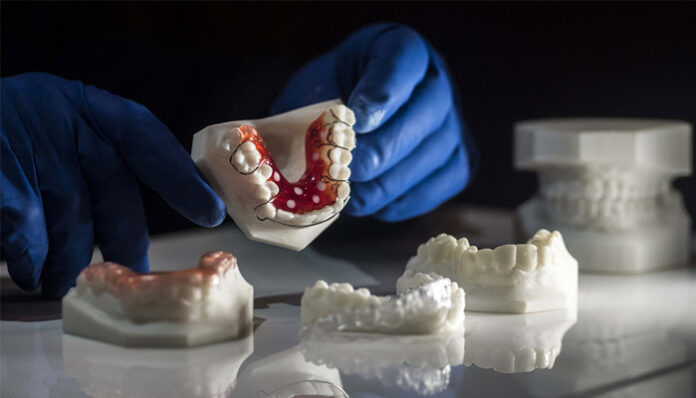Global dental 3D printing market is flourishing majorly due to a spurring demand for dental treatments, products, equipment, and solutions from the worldwide population that has a high prevalence of oral and dental diseases…
BlueWeave Consulting, a leading strategic consulting and market research firm, in its recent study estimated Global Dental 3D Printing Market size at USD 2.72 billion in 2021. Also, BlueWeave forecasts Global Dental 3D Printing Market size to reach a value of USD 12.18 billion by 2028, by growing at an impressive CAGR of 24.2% between 2022 and 2028. A high prevalence of tooth decay (dental caries) in permanent teeth among the global population spurs the demand for dental treatment and tooth replacement. This, in turn, is expected to drive the expansion of dental 3D printing products and solutions industry worldwide at a significant growth rate during the forecast period (2022–2028).
Global Dental 3D Printing Market – Overview
Global 3D printing medical devices market is booming due to the expanding biomedical application, a high prevalence of dental and orthopedic diseases, the ease with which customized medical products can be developed using 3D printing, the expanding use of 3D printing in the healthcare sector, the accessibility of advanced 3D printing materials for dental and medical applications, and a rising demand for 3D-printed goods in dental and the overall medical sector. Global dental 3D printing market is an emerging market that grows continuously owing to the fast integration of innovative technologies, including the Internet of Things (IoT), Artificial Intelligence (AI), and cloud computing. However, high 3D printing costs, rising payment issues, escalating copyright and patent issues, and a shortage of experienced personnel may restrain the market growth.
Request for Sample Report @ https://www.blueweaveconsulting.com/report/dental-3d-printing-market/report-sample
Growth Factors
Rapidly Increasing Number of Use Cases of 3D Printing in Dental Treatments and Solutions
Dental device manufacturers employ 3D printers to create a range of products, including those with intricate geometry or features that are specific to a patient’s anatomy. A standard design is used to print a small number of devices, after which numerous exact replicas of the same device are created. The patient-specific imaging data is used to develop additional devices, sometimes known as patient-matched or patient-specific devices. The choice of technology for 3D printing is influenced by various elements, including the printer’s ease of use and the intended purpose of printed objects.
The most popular technology for 3D printing medical equipment is powder bed fusion. This method works with a variety of components made of nylon and titanium, which are employed in medical equipment. With 3D printing, it is inexpensive and straightforward to produce patient-specific, tactile reference models from scans. These models give dentists a different viewpoint to better prepare for operations, which dramatically cuts down on the length and cost of the actual surgery carried out in the operating room. Patients may benefit from this in the form of increased satisfaction, decreased anxiety, and accelerated healing.
Challenge: Shortage of Skilled Workforce in Dental 3D Printing
Skilled workforce in the dental 3D printing area is in short supply. There is a very limited pool of experienced staff in 3D printing processes, which is exacerbated by the rapid pace of evolution of the dental 3D printing market in terms of technology and materials. Moreover, there are few training programs for dental 3D printing, and there is a significant gap between academia and practical applications in the industry that is difficult to bridge. Shortage of workforce with a thorough understanding of the design process and production cycle has a negative impact on product quality. Hence, limited availability of experienced and skilled personnel in dental 3D printing could restrain the growth of global dental 3D printing market.
Segmental Coverage
Global Dental 3D Printing Market – By Technology
Global dental 3D printing market is segmented based on material type, equipment type, types of services, technology, application, end-user facilities, and regions. By technology, global dental 3D printing market is divided into VAT photopolymerization ((stereolithography (SLA), digital light processing (DLP), and liquid crystal display (LCD)), fused deposition modeling (FDM), selective laser sintering (SLS), polyjet, and others segments. Among technologies, the VAT photopolymerization segment holds a major market share in global dental 3D printing market, and is expected to continue its dominance during the projected period (2022–2028).
Impact of COVID-19 on Global Dental 3D Printing Market
COVID-19 pandemic affected every industry sector across the globe. The pandemic is an unprecedented global public health threat, and when it was present, there were serious resource shortages for hospital beds, medical supplies, and personnel, which resulted in human misery. Manufacturers were unable to produce and sell medical supplies because of labor shortage induced by lockdown. During the pandemic, global healthcare systems encountered numerous challenges, as COVID-19 patients had acute respiratory distress syndrome (ARDS), which necessitated high-level respiratory support for them to survive. The need for 3D printing in the healthcare industry has dramatically increased during the pandemic due to the equipment shortage. Initially, COVID-19 affected dental 3D printing market, as dental clinics were closed due to lockdowns and non-essential dental treatment procedures were postponed to focus on treating increasing number of COVID-19 patients. The scarcity of equipment for the COVID-19 battle caused by the pandemic and its negative effects were the biggest challenges for dental 3D printing market worldwide.
Competitive Landscape
Global dental 3D printing market is highly competitive and fragmented with large multinational corporations and startups. Major players in global dental 3D printing market include Stratasys, 3D Systems, Roland DG Corporation, Envision Tec US LLC, DWS Systems SRL, Align Technology, FormLabs, Prodways Group, SLM solutions, Carbon Inc., Concept Laser, EOS GmbH, and Rapid Shape GmbH. These companies execute a variety of strategic activities, such as mergers and acquisitions, partnerships, and new product launches, to gain a competitive edge over their rivals in global dental 3D printing market.
Contact Us:
BlueWeave Research Blog
Phone No: +1 866 658 6826
Email: info@blueweaveconsulting.com














